It has been an exciting year for our artichoke trials in Hastings!
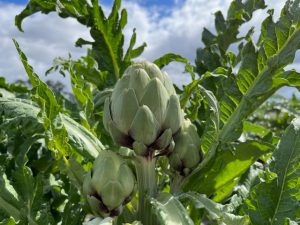
After completing three years of variety trials, we came out with some exciting findings and have been sharing our results!
Back in 2017, our retired director, Gary England, teamed up with Dr. Shinsuke Agehara to explore the opportunity for globe artichoke production in north Florida. They started with three varieties, and eventually expanded to review a total of six. By 2019, I was fortunate to be added to the team! A little background information on artichokes though is needed before I continue.
First, globe artichoke production is predominantly coming from California. A vast majority actually – nearly 99% of the market is being shipped from the West coast. The justification for studying this crop was to assess if we can grow this crop on the East coast. We also wanted to determine if our Florida palate’s found it appetizing. Purchasing a fresh, local commodity is also a major benefit for chefs and consumers, with economic benefits of shorter travels, meaning a less expensive piece of produce.
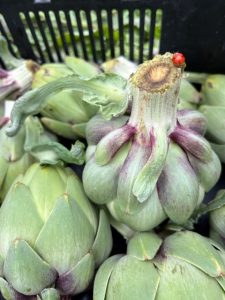
Now keep in mind – Florida and California climates are quite different. We are superior regarding heat and humidity, which brings it challenges. Also, globe artichokes are native to a Mediterranean climate – cool, mild winters. This makes north Florida promising, but we still do not acquire the same chill as California. Our UF/IFAS Hastings farm team assists by applying a plant growth regulator, Gibberellic acid, to the plants while in the early, vegetative stage. This natural hormone assist with inducing bud development, but timing is important, as Dr. Agehara addresses in his research in Balm.

By 2020, we proved that we can grow these plants in Northeast Florida! Exciting! However, there are great differences in yield by variety. Among the six: Colorado Red Star, Green Globe Improved, Green Queen, Imperial Star, Opal and Purple Romagna – Green Queen was the greatest yielding of them all. This is useful for farmers to know which varieties will provide the maximum production per acre. But does the public/consumers find them appealing when Florida-grown?
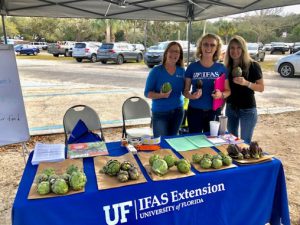
To answer this question, we visited the St. Augustine Amphitheater’s Farmer’s Market. Based on “curb appeal,” shoppers voted (n = 83) on their favorite variety. The ‘Green Queen’ was the fan favorite, followed by ‘Colorado Red Star.’ We did not provide any taste testing; just an assessment of which varieties are the most eye catching to consumers. This very helpful feedback allowed me to select the variety used for the next round of trials: nutrient management.
Before this blog turns into a literature review, know that our focus on phosphorus rate work is currently underway! But that is another blog for another day. As these trials are happening, I was able to publish an article in Edible Northeast Florida Magazine. The goal was to highlight our trials, and experiment with these artichokes in local restaurants.
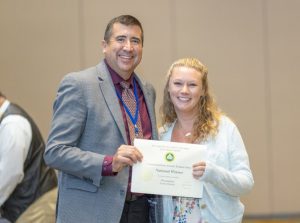
Flash forward to 2022! I submitted this work for the “Feature Story” award through FACAA. It was selected as a State Finalist, and then continued to reach Southern Region and National Finalist. At the 2022 National Association of County Agricultura Agents conference, our work won the National Award! Over 1,000 Extension Agents from across the country had the opportunity to learn and read about our artichoke trials. This was also a great way to bring awareness to UF/IFAS research.
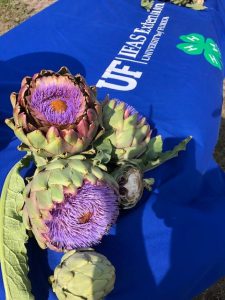
This will be the first year that St. Johns County growers test the market with Florida-grown artichokes. Even better, we have a secondary market with the floriculture industry – cut artichoke flowers. Beautiful, fragrant and a unique bloom just in time for Mother’s Day! Our friends at Bee Hill Farm & Blooms were kind enough to experiment with the timing of bloom development, and consumer feedback at the farmer’s market. Of their 36 donated stems, they sold out in 30 minutes. I think it’s safe to say that the demand is there!
Long story, short: Research takes time, and awareness takes effort. Our road to Florida-grown artichokes has taken many years and paths, but with grower and Extension support, we have many more opportunities to explore and share!
 10
10
